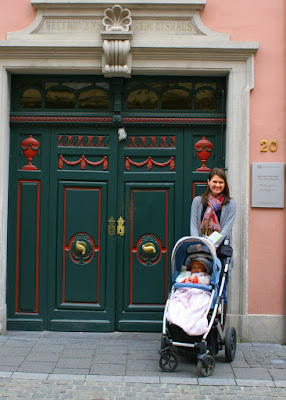 On our way to Amsterdam we made a stop in the German cities of Bonn and Cologne. Joe and Liz came along for the ride because they were stranded in Germany due to the volcanic ash (see previous post). We were grateful for the extra set of hands for keeping Penelope happy and entertained while travelling. As you can see, they did a pretty good job.
On our way to Amsterdam we made a stop in the German cities of Bonn and Cologne. Joe and Liz came along for the ride because they were stranded in Germany due to the volcanic ash (see previous post). We were grateful for the extra set of hands for keeping Penelope happy and entertained while travelling. As you can see, they did a pretty good job.Bonn fact #2: It has a pedestrian-only old town filled with shops and cafes.
Bonn fact #3: There isn't a whole lot to see there.
Which is why I could only come up with a whopping three pictures from our visit to Bonn.
Picture #2: Penelope and I in front of Beethoven's house.
Beethoven was born here in 1770. His father was a court musical director at the palace in Bonn and his grandfather was a court singer. Beethoven's father promoted him as a Mozart-like child prodigy around the city, and by his early teens Beethoven was already working as a court musician in Bonn.
When Bonn was the capital of West Germany, VIP's such as Charles de Gaule and John F. Kennedy appeared before the German people on these steps (the only part of the building not covered by canvas).
Moving on...
Our next stop was Cologne. Or, as the Germans say, Köln.
Cologne Fact #1: It is Germany's fourth largest city.
Cologne Fact #2: It is old! In 50 A.D. Roman Emperor Claudius first recognized Cologne (Colonia) as a Roman city after he married Agrippina (Nero's mother) who was born in Cologne.
Cologne Fact #3: Eau de Cologne was first made here by an Italian chemist in 1709.
Cologne Fact #4: WWII bombs destroyed 95% of the city.
Cologne Fact #5: The reason most people visit Cologne is to see this:
The second you walk out of the train station, you are met with the enormous Cologne Cathedral.
Work began on the cathedral in 1248, but it wasn't finished until the 19th century with the tall spires being the last part completed.
The cathedral was originally built to house the relics of the Three Magi, which were transferred from Milan to Cologne in 1164.
All the ornate stone carvings at the entrances reminded us of the cathedral in Strasbourg, France (see previous post).
The extremely long and tall (140 foot ceilings) nave make you feel very small indeed.
Looking towards the choir, the oldest part of the cathedral.
The Shrine of the Magi, a 7-foot chest of gilded silver that holds the bones of the Three Kings and has inspired Christians to make a pilgrimage here for almost a thousand years.
The Chapel of the Three Magi at the back center of the cathedral directly behind the shrine. It is the oldest section of the cathedral and features the oldest window from 1265. It's called the Bible Window because it is comprised of a vertical strip of Old Testament depictions on the left and corresponding New Testaments depictions on the right. For example, in the middle you can see the Passover Supper on the left, which corresponds to the Lord's Supper on the right.
A modern take on stained glass windows: German artist Gerhard Richter's new creation "harmony of colors." You either love it or you hate it.
The oldest surviving monumental crucifix north of the Alps--976 A.D.
I couldn't find anything about this altar piece, but I really like it.
The Altar of the Poor Clares (1350). It's from the former Franciscan convent of St. Clare in Cologne and is the oldest remaining sacrament altar with a permanently fixed tabernacle. The top row has carvings of various female and male saints while the bottom row has the busts of some of the St. Clares.
The painting on the back of the center panel.
This is where we found Joe after we were done exploring the cathedral: sitting on the remains of the Roman gate to the city from 50 A.D.
Speaking of Joe...We promised him his very own large mug of German beer (think Oktoberfest) before he left, and somehow he had made it through almost a week of visiting Germany without one. Since it was his last day in Germany, we sought out a traditional German brewery and sat down to order one. Little did we realize that Cologne has its own way of doing beer. First of all, it is called Kölsch and it is only served in very small, skinny glasses. So alas, Joe never did get his picture grasping a huge mug of German beer. Poor Joe!
Liz and I in front of the Stapelhaeuschen, after the cathedral the most photographed spot in the city due to the colorful preserved buildings from the 17th century.
And another pic, but with the fam. (Just trying to let the street live up to its reputation.)
That about sums up our visit to Cologne/Köln. Next stop: Amsterdam























No comments:
Post a Comment